Converting the 1/72nd scale Revel Flower Class Corvette to the
Salvage Tug S.S. SUDBURY
|
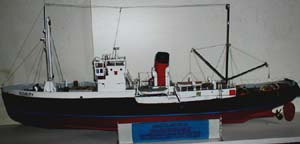 |
Introduction
After my last conversion (HMCS Agassiz),
I found that I had an almost complete kit left and being a Scotsman and
deciding not to waste anything. I did a bit of research on the Internet
and found that one of the ex-Canadian Navy Flower class corvettes, HMCS
Sudbury, was converted postwar to a rescue tug under the same name. Used
by a firm called "Island Tug & Barge Company" of Vancouver British Columbia.
I contacted both Seaspan (the current owners of the Island Tug & Barge
Company) and The Maritime Museum of British Columbia in Vancouver for
what assistance they could give me.
Builders drawings to 1/72nd scale were purchased from the Maritime
museum of British Columbia along with photographs of the ship and the
conversions started. This is the result.
S.S. SUDBURY
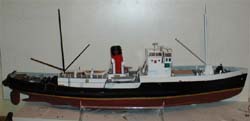 Sudbury
was a 60 meter salvage tug famous for its mid-ocean rescues. She began
life as the RCN Corvette, HMCS Sudbury, built in Ontario in 1941. After
WW2 ended she was converted to a towboat and Harold Elworthy, owner of
Island Tug & Barge bought her in 1954. The Sudbury and her crew specialized
in deep-sea salvage and completed many dramatic operations, but made their
reputation in November/December 1955 when they pulled off the daring North
Pacific rescue of the Greek freighter Makedonia. Sudbury
was a 60 meter salvage tug famous for its mid-ocean rescues. She began
life as the RCN Corvette, HMCS Sudbury, built in Ontario in 1941. After
WW2 ended she was converted to a towboat and Harold Elworthy, owner of
Island Tug & Barge bought her in 1954. The Sudbury and her crew specialized
in deep-sea salvage and completed many dramatic operations, but made their
reputation in November/December 1955 when they pulled off the daring North
Pacific rescue of the Greek freighter Makedonia.
 The
Sudbury towed the disabled vessel for 40 days through some of the roughest
weather imaginable before arriving safely into Vancouver to a hero's welcome.
The incident made headlines around the world and for the next decade the
Sudbury and her 65-meter sister ship Sudbury II, purchased by Island Tug
in 1958 were the most famous tugs on the Pacific coast. The
Sudbury towed the disabled vessel for 40 days through some of the roughest
weather imaginable before arriving safely into Vancouver to a hero's welcome.
The incident made headlines around the world and for the next decade the
Sudbury and her 65-meter sister ship Sudbury II, purchased by Island Tug
in 1958 were the most famous tugs on the Pacific coast.
The original Sudbury was damaged during repairs and was dismantled
for scrap in 1966. Following the mergers that created Sea span International.
The Sudbury II remained in service until 1979 when she was sold and converted
into a fishing vessel by her new owners. In 1982 she sank in Hecate Strait
The Sudbury
 The
kit hull was put together as per the kit instructions then the excess
keel moulding from bow to stern is removed as this is incorrect for the
ships of the class. The excessive gaps in the joint plates of the hull
were filled with P38 and sanded down to give a more realistic look to
the hull. The bulwarks around the quarter deck were removed to the level
of the freeing ports and deck level and the stern is squared off by using
heat applied to the stern and placed against a flat surface, when the
hull begins to soften a gentle pushing will shape it to the required shape. The
kit hull was put together as per the kit instructions then the excess
keel moulding from bow to stern is removed as this is incorrect for the
ships of the class. The excessive gaps in the joint plates of the hull
were filled with P38 and sanded down to give a more realistic look to
the hull. The bulwarks around the quarter deck were removed to the level
of the freeing ports and deck level and the stern is squared off by using
heat applied to the stern and placed against a flat surface, when the
hull begins to soften a gentle pushing will shape it to the required shape.
New decking was cut using the kit decks as a guide and the quarterdeck
area squared off that the stern, the access area is cut out after measuring
the distance for the new engine room casing. This casing deck is modified
from the kit by removing the 2pdr gun mount and filling the resulting
hole, the engine room skylight hole is filled and the new enlarged skylight
moved to the correct position further aft.
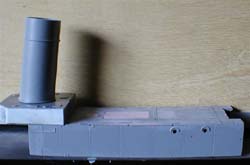 The
actual engine room casing sides are shortened [from the forward end to
allow for the camber on the deck] by 80mm .The funnel housing is fitted
to the front of the casing to make it into a one-piece fitting. The
actual engine room casing sides are shortened [from the forward end to
allow for the camber on the deck] by 80mm .The funnel housing is fitted
to the front of the casing to make it into a one-piece fitting.
The extra port holes [lower group forward and those below the quarter
deck] in the hull were filled in and sanded. The new quarterdeck was fitted
into place and secured, any gaps left being filled with P38 and sanded.
 The
replacement bulwarks were cut after making a template from card to ensure
the correct shape and the outside built up using again P38 where required.
New plates were cut to size and put in place to follow the hull-plating
pattern. The capping rail was then added to continue the detail from the
main hull. The rubbing strip round the quarterdeck was added and the completed
hull sprayed matt black above the waterline and matt red below with a
white boot topping marking the waterline. The
replacement bulwarks were cut after making a template from card to ensure
the correct shape and the outside built up using again P38 where required.
New plates were cut to size and put in place to follow the hull-plating
pattern. The capping rail was then added to continue the detail from the
main hull. The rubbing strip round the quarterdeck was added and the completed
hull sprayed matt black above the waterline and matt red below with a
white boot topping marking the waterline.
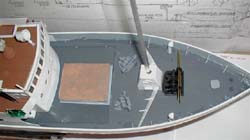 The
new fore deck was cut and fitted into place with an access hatch being
cut and fitted to take the forward superstructure. Owing to this being
a flat structure and the need for the superstructure to be secured , a
ledge was stuck in place all round the hatch and the deck with the superstructure
in place was fitted unto a bed of light grease [Vaseline to ensure a watertight
seal] The
new fore deck was cut and fitted into place with an access hatch being
cut and fitted to take the forward superstructure. Owing to this being
a flat structure and the need for the superstructure to be secured , a
ledge was stuck in place all round the hatch and the deck with the superstructure
in place was fitted unto a bed of light grease [Vaseline to ensure a watertight
seal]
 New
bulwarks were added round the fore deck as far back as the bridge superstructure
and the required bulwark supports were put into place after painting light
grey. These are also cut and put into place round the rear deck. New
bulwarks were added round the fore deck as far back as the bridge superstructure
and the required bulwark supports were put into place after painting light
grey. These are also cut and put into place round the rear deck.
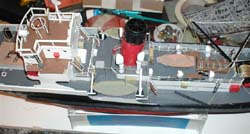 The
superstructure was built as per the drawings. Glazing was added inside
the windows as were the bridge interior details and since I intend to
have operating lights they too were added before painting and final assembly
of the separate levels. The radar mast was put into place and the drive
for the radar extended to below the superstructure. The rails around the
superstructure made from plastic covered wire and plastic angle. Various
boxes were put in place on the bridge to make it look more lifelike. The
forward hatch was made and put in place in front of the bridge structure. The
superstructure was built as per the drawings. Glazing was added inside
the windows as were the bridge interior details and since I intend to
have operating lights they too were added before painting and final assembly
of the separate levels. The radar mast was put into place and the drive
for the radar extended to below the superstructure. The rails around the
superstructure made from plastic covered wire and plastic angle. Various
boxes were put in place on the bridge to make it look more lifelike. The
forward hatch was made and put in place in front of the bridge structure.
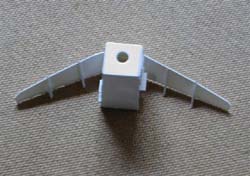 The
foremast support consisting of the crew and storage access doors with
breakwater is made and painted before fitting into place. The
foremast support consisting of the crew and storage access doors with
breakwater is made and painted before fitting into place.
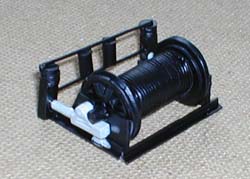 The
towing winch was made from scrap bits and pieces and fitted to the quarter
deck at the rear of the engine room casing The
towing winch was made from scrap bits and pieces and fitted to the quarter
deck at the rear of the engine room casing
The ships boats are carried covered and to simulate the canvas covering
toilet paper was sprayed green and put into place on the boats
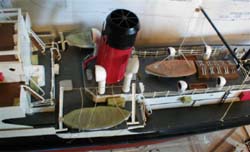 Deck
rails were made from Billings 3 hole stanchions and white thread to make
the actual guard rails. The masts are made from aluminium tubing of different
sizes and to give the required taper they are sleeved inside each other
for the required length 9.5î for the foremast & 9.25" for The main mast.
Collars for the jibs are cut again from tubing and put into place. Using
the same system as the masts by sleeving the different sizes until the
required taper is produced makes the jibs themselves. Deck
rails were made from Billings 3 hole stanchions and white thread to make
the actual guard rails. The masts are made from aluminium tubing of different
sizes and to give the required taper they are sleeved inside each other
for the required length 9.5î for the foremast & 9.25" for The main mast.
Collars for the jibs are cut again from tubing and put into place. Using
the same system as the masts by sleeving the different sizes until the
required taper is produced makes the jibs themselves.
The fore mast is drilled 3" from the top, then at 4" & 5" for the mast
lights which are then wired up together and inserted down the inside of
the mast to emerge under the foredeck. And are connected to the interior
and search lights, the main mast is also drilled for lights which again
is wired to the other ships lights so that when the lights are switched
on all lights come on at the same time
Life Boat davits of the Welin Lum type are made and put in place along
with the falls and other rope works.
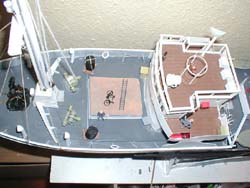 Various
details such as small winches, storage boxes etc are put in place on the
decks to give a busy look Various
details such as small winches, storage boxes etc are put in place on the
decks to give a busy look
The rigging is now fitted where required and where there are re-moveable
areas of superstructure the rigging is also made removable by fixing it
through small hooks that are not too visible to the on looker.
During the course of this conversion I used as many of the kit parts
as possible either straight from the box or customised to suit their new
purpose. Parts bought for the ship are at a minimum.
References:
|

 Sudbury
was a 60 meter salvage tug famous for its mid-ocean rescues. She began
life as the RCN Corvette, HMCS Sudbury, built in Ontario in 1941. After
WW2 ended she was converted to a towboat and Harold Elworthy, owner of
Island Tug & Barge bought her in 1954. The Sudbury and her crew specialized
in deep-sea salvage and completed many dramatic operations, but made their
reputation in November/December 1955 when they pulled off the daring North
Pacific rescue of the Greek freighter Makedonia.
Sudbury
was a 60 meter salvage tug famous for its mid-ocean rescues. She began
life as the RCN Corvette, HMCS Sudbury, built in Ontario in 1941. After
WW2 ended she was converted to a towboat and Harold Elworthy, owner of
Island Tug & Barge bought her in 1954. The Sudbury and her crew specialized
in deep-sea salvage and completed many dramatic operations, but made their
reputation in November/December 1955 when they pulled off the daring North
Pacific rescue of the Greek freighter Makedonia.  The
Sudbury towed the disabled vessel for 40 days through some of the roughest
weather imaginable before arriving safely into Vancouver to a hero's welcome.
The incident made headlines around the world and for the next decade the
Sudbury and her 65-meter sister ship Sudbury II, purchased by Island Tug
in 1958 were the most famous tugs on the Pacific coast.
The
Sudbury towed the disabled vessel for 40 days through some of the roughest
weather imaginable before arriving safely into Vancouver to a hero's welcome.
The incident made headlines around the world and for the next decade the
Sudbury and her 65-meter sister ship Sudbury II, purchased by Island Tug
in 1958 were the most famous tugs on the Pacific coast.  The
kit hull was put together as per the kit instructions then the excess
keel moulding from bow to stern is removed as this is incorrect for the
ships of the class. The excessive gaps in the joint plates of the hull
were filled with P38 and sanded down to give a more realistic look to
the hull. The bulwarks around the quarter deck were removed to the level
of the freeing ports and deck level and the stern is squared off by using
heat applied to the stern and placed against a flat surface, when the
hull begins to soften a gentle pushing will shape it to the required shape.
The
kit hull was put together as per the kit instructions then the excess
keel moulding from bow to stern is removed as this is incorrect for the
ships of the class. The excessive gaps in the joint plates of the hull
were filled with P38 and sanded down to give a more realistic look to
the hull. The bulwarks around the quarter deck were removed to the level
of the freeing ports and deck level and the stern is squared off by using
heat applied to the stern and placed against a flat surface, when the
hull begins to soften a gentle pushing will shape it to the required shape.
 The
actual engine room casing sides are shortened [from the forward end to
allow for the camber on the deck] by 80mm .The funnel housing is fitted
to the front of the casing to make it into a one-piece fitting.
The
actual engine room casing sides are shortened [from the forward end to
allow for the camber on the deck] by 80mm .The funnel housing is fitted
to the front of the casing to make it into a one-piece fitting. The
replacement bulwarks were cut after making a template from card to ensure
the correct shape and the outside built up using again P38 where required.
New plates were cut to size and put in place to follow the hull-plating
pattern. The capping rail was then added to continue the detail from the
main hull. The rubbing strip round the quarterdeck was added and the completed
hull sprayed matt black above the waterline and matt red below with a
white boot topping marking the waterline.
The
replacement bulwarks were cut after making a template from card to ensure
the correct shape and the outside built up using again P38 where required.
New plates were cut to size and put in place to follow the hull-plating
pattern. The capping rail was then added to continue the detail from the
main hull. The rubbing strip round the quarterdeck was added and the completed
hull sprayed matt black above the waterline and matt red below with a
white boot topping marking the waterline.  The
new fore deck was cut and fitted into place with an access hatch being
cut and fitted to take the forward superstructure. Owing to this being
a flat structure and the need for the superstructure to be secured , a
ledge was stuck in place all round the hatch and the deck with the superstructure
in place was fitted unto a bed of light grease [Vaseline to ensure a watertight
seal]
The
new fore deck was cut and fitted into place with an access hatch being
cut and fitted to take the forward superstructure. Owing to this being
a flat structure and the need for the superstructure to be secured , a
ledge was stuck in place all round the hatch and the deck with the superstructure
in place was fitted unto a bed of light grease [Vaseline to ensure a watertight
seal] New
bulwarks were added round the fore deck as far back as the bridge superstructure
and the required bulwark supports were put into place after painting light
grey. These are also cut and put into place round the rear deck.
New
bulwarks were added round the fore deck as far back as the bridge superstructure
and the required bulwark supports were put into place after painting light
grey. These are also cut and put into place round the rear deck. The
superstructure was built as per the drawings. Glazing was added inside
the windows as were the bridge interior details and since I intend to
have operating lights they too were added before painting and final assembly
of the separate levels. The radar mast was put into place and the drive
for the radar extended to below the superstructure. The rails around the
superstructure made from plastic covered wire and plastic angle. Various
boxes were put in place on the bridge to make it look more lifelike. The
forward hatch was made and put in place in front of the bridge structure.
The
superstructure was built as per the drawings. Glazing was added inside
the windows as were the bridge interior details and since I intend to
have operating lights they too were added before painting and final assembly
of the separate levels. The radar mast was put into place and the drive
for the radar extended to below the superstructure. The rails around the
superstructure made from plastic covered wire and plastic angle. Various
boxes were put in place on the bridge to make it look more lifelike. The
forward hatch was made and put in place in front of the bridge structure. The
foremast support consisting of the crew and storage access doors with
breakwater is made and painted before fitting into place.
The
foremast support consisting of the crew and storage access doors with
breakwater is made and painted before fitting into place.  The
towing winch was made from scrap bits and pieces and fitted to the quarter
deck at the rear of the engine room casing
The
towing winch was made from scrap bits and pieces and fitted to the quarter
deck at the rear of the engine room casing Deck
rails were made from Billings 3 hole stanchions and white thread to make
the actual guard rails. The masts are made from aluminium tubing of different
sizes and to give the required taper they are sleeved inside each other
for the required length 9.5î for the foremast & 9.25" for The main mast.
Collars for the jibs are cut again from tubing and put into place. Using
the same system as the masts by sleeving the different sizes until the
required taper is produced makes the jibs themselves.
Deck
rails were made from Billings 3 hole stanchions and white thread to make
the actual guard rails. The masts are made from aluminium tubing of different
sizes and to give the required taper they are sleeved inside each other
for the required length 9.5î for the foremast & 9.25" for The main mast.
Collars for the jibs are cut again from tubing and put into place. Using
the same system as the masts by sleeving the different sizes until the
required taper is produced makes the jibs themselves. Various
details such as small winches, storage boxes etc are put in place on the
decks to give a busy look
Various
details such as small winches, storage boxes etc are put in place on the
decks to give a busy look